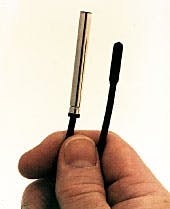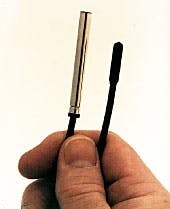New temperature sensor
A new series of Italcoppie brand RTD probes provide rugged, long-lasting, and accurate temperature sensing in harsh operating conditions and corrosive environments.
The IKE series of platinum RTD probes features a one-piece molded design with a vulcanized cover protecting the sensor exterior, including the vulnerable transition area where the sensor and cable are joined. They are moisture, temperature, and corrosion resistant and suited for long-term immersion.
Probes are available with either Pt 100 or Pt 1000 sensing elements and a choice of IEC Class B or Class A accuracy specifications. The attached thermoplastic cables may be ordered in lengths up to 5,000 mm (16 ft) and are available in either two-wire or four-wire configurations.
The 3.5 mm diameter outer cable has ambient temperature limits of -50° C. to 105° C. (-58° to 221° F.). The probe tip containing the RTD sensor is 5 mm in diameter and 20 mm long.
Source: Palmer Wahl Instrumentation Group, 234 Weaverville Highway, Asheville, NC 28804-1228.
Grounding assembly for floating roof tanks
A new retractable grounding assembly (RGA) is designed for liquid storage tanks with floating roofs.
The new device reduces the bound charge hazard by equalizing the floating roof and tank wall potential, reducing any secondary arc hazard. Bound charge can be 1,000 times more common than direct lightning strikes, the firm points out. With impedance of 1 ohm or less, the RGA ensures a reliable, full-time grounding connection.
Bound charge occurs when a storm cell induces an electrical charge on everything beneath it, including metal containers and the flammable product within them. Secondary arc, leading to rim fires or explosions, results when the electrical charge differential between a tank wall and its floating roof rises to the point where the charge can bridge the small air gap between the structures before it can be equalized. A nearby lightning strike, or even filling or emptying a tank quickly, can cause this to occur, the firm says.
The RGA uses a wide, thick-braided wire wound on a reel for maximum conductivity. Retractable 480/30 copper wire aligns vertically beneath either a top edge or angle mount and attaches to the floating roof, serving as a ready, efficient grounding conductor.
The RGA's wide braid maximizes surface area and conductivity, because electrical charges travel most effectively along the surface of a wire. In addition, a spring-loaded reel extends wiring as the roof descends, and retracts it as the roof rises-so the line remains taut at the minimal distance needed for grounding.
One RGA is effective for tanks with diameters as large as 30 m, with more recommended for tanks of larger size.
Source: Lightning Eliminators & Consultants Inc., 6687 Arapahoe Rd., Boulder, CO 80303.
Catalog features control, instrumentation products
A minicatalog, yours free upon request, provides an overview of more than 150 control and instrumentation products.
Patented Swichgage control instruments are featured.
Products monitor pressure, temperature, level, vibration, time, and overspeed; and in the event of potentially damaging conditions an alarm or automatic shutdown may be initiated. The company makes devices for monitoring, protection, control, and automation; electric gauges; engine panels and controllers; electric motor controls; and complete process control systems.
Source: FW Murphy, Box 470248, Tulsa, OK 74147.
3D seismic processing software
New 3D finite difference prestack depth migration processing software is on the market.
The company has customized this software for optimal performance in the supercluster environment. The program promises to run well on this firm's system and can offer savings in this computation-intensive processing technique.
Source: Fairfield Industries, 14100 Southwest Freeway, Suite 600, Sugar Land, TX 77478.
Drilling software
UK firm Advantica Technologies Ltd. and Houston-based Technical Toolboxes Inc. have launched the drillstring dynamics calculator (DDC) software package, a new program that will enable users to extend the working life of the drillstem by predicting the rotary drilling speeds that cause resonance.
Advantica developed the user friendly, windows-based program, which will be marketed by Technical Toolboxes.
DDC's objective is to prevent failures before they occur by extending the life of the drillstem so that total depth can be reached without a washout or a twist-off.
The software can be applied onshore and offshore and works by analyzing the drillstring in sections of the well from the surface to total depth, showing vibration against drilling speed. Graphical representations of the drillstring vibration enable DDC to produce easy to interpret results that will immediately show where problematic vibrations are occurring.
Source: Advantica Technologies Ltd., Ashby Rd., Loughborough Leicestershire LE11 3GR, UK.



